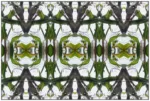Tim Portlock’s carefully constructed digital landscapes of the post-industrial sublime are deeply uncanny. His debut solo show at Locks Gallery brings together two major bodies of work, focused on Philadelphia (2011) and San Bernadino, CA (2015). Both cities are under considerable economic strain, making them fitting for Portlock’s vision of almost post-Apocalyptic destruction that is at the same time futuristic and all too real.
The artist and 2011 Pew Fellow’s unique process involves photography, 3D modelling, animation, and digital effects to create compellingly hybrid images. The show also includes two video animations based on the themes and urban landscapes explored in the still images. The video loop in the main gallery consists of a sequence of animated GIFs relating to Las Vegas construction projects abandoned in the wake of the 2008 collapse of the housing market, while a video projection in a separate room re-imagines the urban geography of the disused railway line north of Philadelphia’s Chinatown district. The video projection was first shown at Vox Populi, of which he has been a member, and he has also shown work in group and solo shows across Philadelphia, including the ICA, PAFA, and the Fleisher Art Memorial. Here at Artblog, Roberta and Libby have spoken to Portlock in the past (see YouTube slide show/podcast below), and he was generous enough to meet with me to discuss his new show.
Despite all the technical know-how that goes into producing this work, there is something distinctly painterly about Portlock’s approach to image-making. and his futuristic landscapes owe a great deal to the golden age of American landscape painting in the nineteenth century. What separates Portlock’s work from the Hudson River School’s optimism is the artist’s pragmatic engagement with the difficult issues facing many American cities in the 21st century, such as the growing socioeconomic divide between rich and poor, the housing crisis, and environmental degradation. He presents a vision of Philadelphia that is terrifyingly realistic, for depending on where you live, litter-filled streets and boarded-up buildings are all too familiar. As a new resident, I still see the scars of poverty and gentrification that crisscross the city, but exposure and familiarity can blunt the impact of painful reality. Bringing together historical references, contemporary issues, and digital technology, he helps us to see our city with new eyes.
Digital dystopias
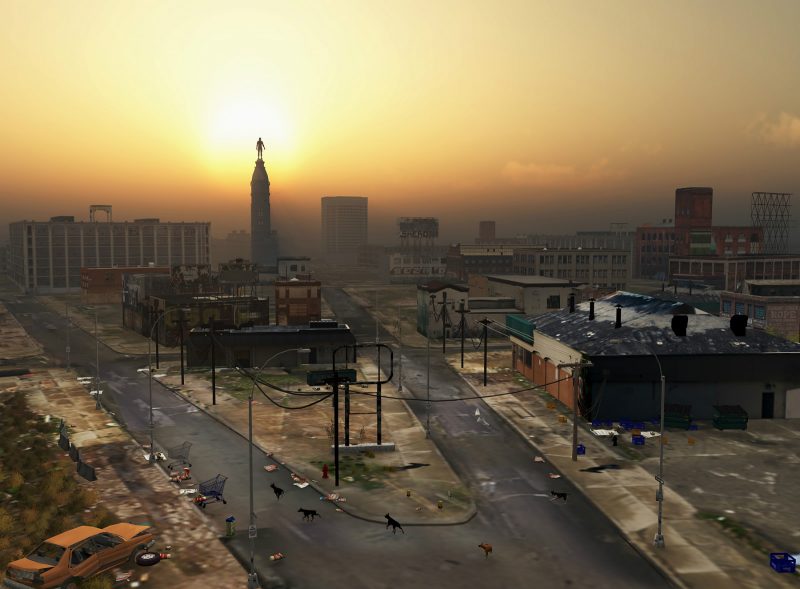
Entering the austere concrete-floored gallery space on the second floor, my eyes were immediately drawn to the back wall, where the gallery’s gray support columns framed a familiar image of Philadelphia’s City Hall. Contrasting to the cool windowless vault-like space surrounding it, the warm golden light of the scene drew me in. As I came closer, however, what at first seemed reassuringly familiar became disturbingly alien. A hazy sunrise illuminated a scene of almost post-Apocalyptic urban blight–a city whose streets are creepily empty of people, inhabited only by roaming packs of dogs, abandoned cars, boarded-up buildings, and litter.
The photorealism of the image began to dissolve as I got closer. In a disorienting reversal of the usual process of perception, where we move from the blurriness of distance to the precision of close-up details, Portlock’s digital dystopias fragment the closer you get to them. What appears seamless and realistic across the space of the gallery devolves into jarring disjunctions of scale. A milk carton in the foreground is almost as large as one of the roaming dogs; crumpled candy wrappers and crushed soda cans are as large as a fire hydrant nearby. The familiar figure of William Penn benignly presiding over his utopian experiment looks more like a figure from a superhero comic, backlit by the sun like a dystopian Rocky.
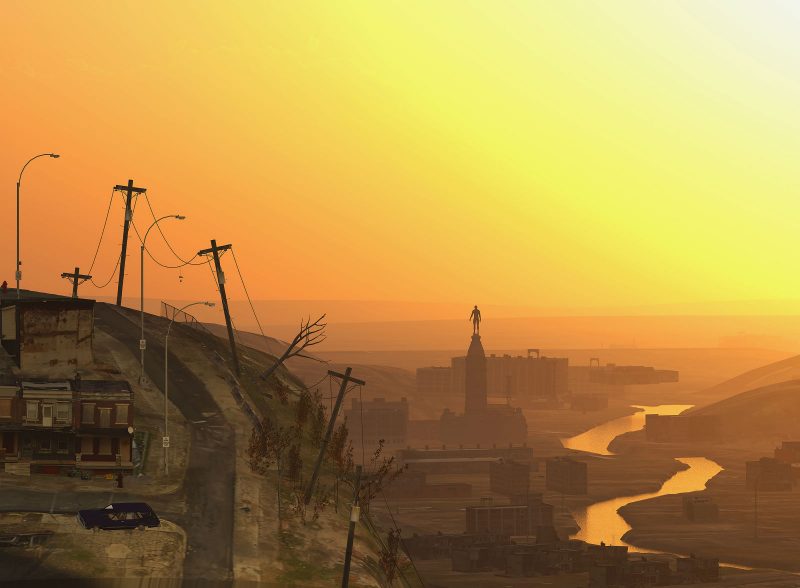
The scenes in Portlock’s Philadelphia series are all bathed in the golden light of sunrise or sunset, as signalled by the titles of the pieces. “Sundown,” hung immediately to the right of “Salon,” shows perhaps the clearest debt to 19th-century American landscape painting. In conversation, Portlock mentioned that Thomas Cole’s 1836 “View from Mount Holyoke” (better known as “The Oxbow”) was a direct inspiration for the composition of the work. Unlike Cole’s preindustrial sylvan setting, Portlock presents us with a virtually treeless, blighted urban landscape–the only tree is a dead trunk poised on the edge of a ravine. Rather than trees, we have telephone poles, which lean not away from the precipice–like the tree in the foreground of Cole’s painting–but seem to be falling higgledy piggledy into the abyss.
Under the California sun
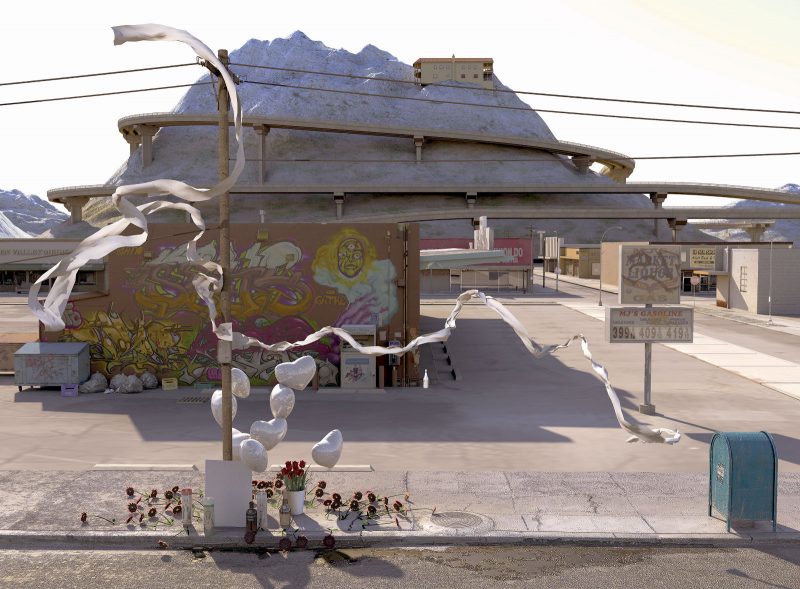
I was immediately drawn to the Philadelphia series because of my personal connection with the city, but Portlock’s most recent work deals with San Bernadino. Unlike the golden light that suffuses the City of Brotherly Love, the California sun in the San Bernadino series is almost painful to look at. It is always high noon in California, the shadows cast from a sun directly above us. In “Memorial,” a small improvised shrine consisting of candles, balloons, flowers, and bottles of liquor huddles in the foreground beneath the shadow of a small rocky mountain. Given the presence of the memorial shrine, the lack of human figures in the image is even more unsettling, suggesting not just passive absence but actual violence and death.
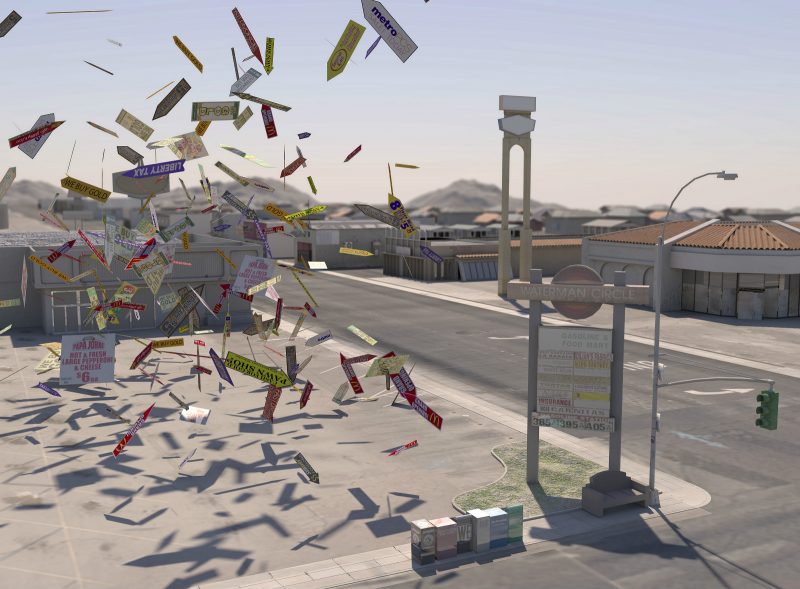
Portlock explained that his focus on San Bernadino was accidental, and came about when he was originally planning to work on the urban landscape of Las Vegas. On his regular trips to Las Vegas, he would travel through San Bernadino. During that time, the foreclosure capital of the country moved from Las Vegas to San Bernadino, and Portlock decided to shift course and think about this less glamorous stop on the way to the casino capital of Nevada. In “Desert Rain,” I see the detritus of the collapse of the real estate market, as dozens of small signs in Spanish and English offer everything from cheap tax filing services to fast food to pawn shops. The parking lot of the strip mall in the foreground is filled not by cars and people, but by the shadows of the surreal ‘desert rain’ of nothingness. Boarded-up businesses and empty roads frame the all-American tumbleweed, hinting at the poverty and despair of the invisible inhabitants.
Tim Portlock’s powerful work combines technological sophistication with sociological awareness of the transformations that many American cities are undergoing in the wake of the economic collapse. Despite–or perhaps precisely because of–the glaring absence of people in his images, there is something deeply humane about his approach to these urban problems. People and place are profoundly connected, and Portlock’s work brings them together in surreal, inventive, and thought-provoking new ways.
Tim Portlock: Ash and Gold is on view until July 15 at Locks Gallery, 600 Washington Square South, Philadelphia, PA 19106.






